
Bar Ordinary
"Ermine, two bars gules. BAR. An honourable ordinary, occupying one-fifth of the shield. It may be placed…

Mammoth
Animals alive today are but a fraction of all that have been before our time. We are continually discovering…
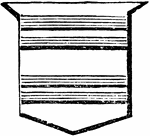
Bars Gemels
"GEMELS. This word signifies double. The example contains two double bars, which in heraldic language…
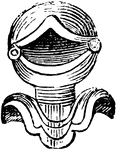
Open Helmet Direct
"The helmet without bars, with the beaver open, standing directly fronting the spectator, denotes a…
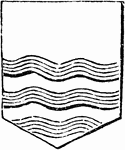
Bars Wavy
"Argent, the lower half of the shield three bars wavy, azure. WAVY. Curved lines, undulating like the…

St. Lucas Thrasher
"Upper parts uniform ashy-brown; wings and tail similar, but rather purer and darker brown, the former…

Glass Fountain
This glass fountain is found in the center of the Crystal Palace in Hyde Park, London. It is supported…
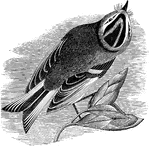
Golden Crested Kinglet
"Upper parts olive-green, more or less bright, sometimes rather olive-ashy, always brightest on the…
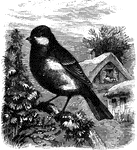
European Greater Titmouse
"Head not crested. Wings and tail rounded, of approximately equal lengths, and about as long as the…

Tufted Titmouse
"Entire upper parts ashy, the back usually with a slight olivaceous shade, the wings and tail rather…
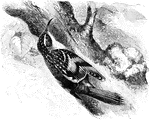
Common Brown Creeper
"Common Brown Creeper. Upper parts dark brown, changing to rusty-brown on the rump, everywhere streaked…

European Wren
"European Wren. Feet strictly laminiplanter, as usual in Oscines. Tail thin, with narrow parallel-edged…

Rock Wren
"Upper parts pale brownish-gray, minutely dotted with blackish and whitish points together, and usually…

Winter Wren
"Winter Wren. Above brown, darker before, brighter behind, most of back, together with tail and inner…
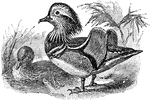
Mandarin Duck
he Mandarin Duck (Aix galericulata), or just Mandarin, is a medium-sized perching duck, closely related…
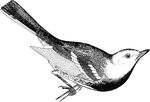
Black Throated Green Warbler
"Black Throated Green Warbler or Dendroica virens. Back and crown clear yellow-olive; forehead, superciliary…

Blue Golden-Winged Warbler
"Blue Golden-Winged Warbler or Helminthophila chrysoptera. Upper parts slaty-blue, or or fine bluish-gray;…
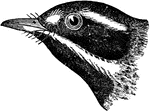
Black-throated Gray Warbler
"Black-throated Gray Warbler or Dendroica nigrescens. Above, bluish-ash, the interscapular region, and…
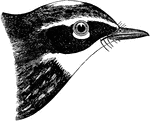
Yellow-rumped Warbler
"Yellow-rumped Warbler or Dendroica coronata. Yellow-crowned Warbler. Myrtle Bird. Slaty-blue, streaked…
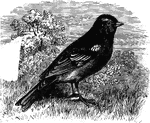
Chaffinch
Fringilla coelebs. Chaffinch. A small finch with edges of the tail being white, white bars on wings,…

Pine Grosbeak
"Pinicola enucleator. Pine Grosbeak. Light carmine or rosy-red, feathers of back with dusky centres;…

White-winged Crossbill
"Loxia leucoptera. White-winged Crossbill. Rosy-red, sometimes carmined or even crimsoned, obscured…

Chipping Sparrow Head
"Spizella domestica. Chipping Sparrow. Chipping Bird or Chippy. Hair-bird. Bill black; feet pale; crown…
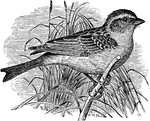
Chipping Sparrow
"Spizella domestica. Chipping Sparrow. Chipping Bird or Chippy. Hair-bird. Bill black; feet pale; crown…
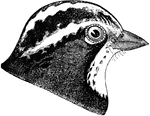
White-throated Sparrow Head
"Zonotrichia albicollis. White-throated Crown Sparrow. Peabody-bird. Crown black divided by a median…

White-crowned Sparrow Head
"Zonotrichia leucophrys. White-browned Crown Sparrow. Crown pure white, enclosing on either side a broad…
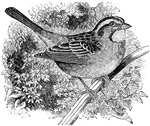
White-throated Sparrow
"Zonotrichia albicollis. White-throated Crown Sparrow. Peabody-bird. Crown black divided by a median…
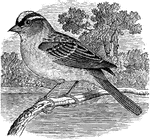
White-crowned Sparrow
"Zonotrichia leucophrys. White-browned Crown Sparrow. Crown pure white, enclosing on either side a broad…
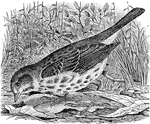
Fox Sparrow
"Passerella iliaca. Eastern Fox Sparrow. General color above ferrugineous or rusty-red, purest and brightest…

Skull of a Common Fowl
"Fig. 62 Skull of common fowl, enlarged. from nature by Dr. R.W. Shufeldt, U.S.A. The names of bones…
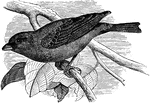
Indigo-bird
"Passerina cyanea. Indigo Painted Finch. Indigo-bird. Adult male: Indigo-blue, intense and constant…

Meadow Lark Foot and Bill
"Sturnella magna. Field Lark. Old-field Lark. Meadow Lark. The colors, as above described, rich and…

Blue Jay
"Cyanocitta cristata. Blue Jay. Male: Purplish-blue, below pale purplish-gray, whitening on throat,…

Small Whippoorwill
"Antrostomus vociferus. Whippoorwill. Night-jar. Upper parts variegated with gray, black, whitish, and…
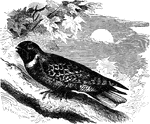
Large Whippoorwill
"Antrostomus vociferus. Whippoorwill. Night-jar. Upper parts variegated with gray, black, whitish, and…

Small Night-hawk
"Chordediles poptue. Night-hawk. Bull-bat. Above, mottled with black, brown, gray and tawny, the former…

Large Night-hawk
"Chordediles poptue. Night-hawk. Bull-bat. Above, mottled with black, brown, gray and tawny, the former…
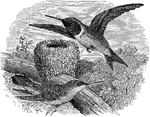
Ruby-throated Humming-bird
"Trochilus colubris. Ruby-throated Humming-bird. Tail forked, its feathers all narrow and pointed; no…
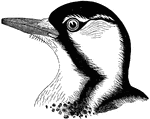
Red-cockaded Woodpecker
"Picus borealis. Red-Cockaded Woodpecker. Body spotted and crosswise banded, but not streaked. Head…
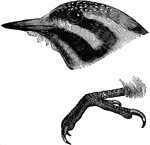
Nuttall's Woodpecker
"Picus scalaris nutalli. Nuttall's Woodpecker. Similar; rather larger' more white, this prevailing on…
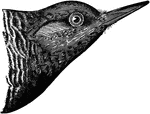
Brown-headed Woodpecker
"Sphyropicus thyroides. Brown-headed Woodpecker. Black-breasted Woodpecker. Red-throated Woodpecker.…
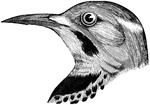
Flicker
"Colaptes auratus. Golden-winged Woodpecker. Pigeon Woodpecker. Flicker. Yucker. High-holder. Back and…
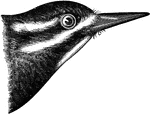
Red-headed Woodpecker
"Sphyropicus thyroides. Brown-headed Woodpecker. Black-breasted Woodpecker. Red-throated Woodpecker.…
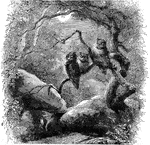
Screech Owls
"Scops. Little Horned Owls. Screech Owls. Like the miniature Bubo in form (all our species under a foot…

Small Barn Owls
"Aluco flammeus pratincola. Barn Owl. above, including upper surfaces of wings and tail, tawny, fulvous,…
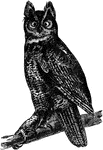
Great Horned Owl
"Bubo virginianus. Great Horned Owl. Hoot Owl. Cat Owl. Distinguished by its large size and conspicuous…

Screech Owl
Scops. Little Horned Owls. Screech Owls. Like the miniature Bubo in form (all our species under a foot…
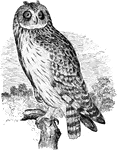
Short-eared Owl
"Asio accipitrinus. Short-eared Owl. Marsh Owl. Ear-tufts inconspicuous, much shorter than middle toe…

Barred Owl
"Strix nebulosa. Barred Owl. Hoot Owl. American Wood Owl. Toes fully feathered, nearly or quite to the…
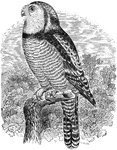
Hawk Owl
"Surnia funerea. American Hawk Owl. Day Owl. Bill and eyes yellow; claws brownish-black. Upper parts…
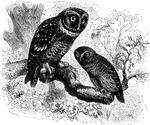
Saw-whet and Sparrow Owls
"Nyctala - Saw-whet Owls. Skull and ear-parts highly unsymmetrical, the the latter of great size, and…

Barn Owls
"Aluco flammeus pratincola. Barn Owl. above, including upper surfaces of wings and tail, tawny, fulvous,…

Burrowing Owl
"Speotyto cunicularia hypogae'a. Burrowing Owl. Adult: Above, dull grayish-brown, profusely spotted…

Marsh Hawk
"Circus cyaneus hudsonius. American Marsh Hawk, Harrier. Blue hawk. Adult Male: In perfect plumage pale…
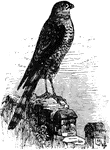
Sharp-shinned Hawk - Small
"Accipiter fuscus. Sharp-shinned Hawk. "Pigeon" Hawk. Above, dark plumbeous, slate-color, or bluish-gray,…

Sharp-shinned Hawk
"Accipiter fuscus. Sharp-shinned Hawk. "Pigeon" Hawk. Above, dark plumbeous, slate-color, or bluish-gray,…
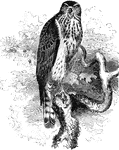
American Goshawk
"Astur atricapillus. American Goshawk. Blue Hen Hawk (adult). Chicken Hawk (young). Adult: Above, dark…
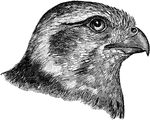
Prairie Falcon Head
"Falco mexicanus. American Lanner Falcon. Prairie Flacon. A medium-sized species, distinguished from…
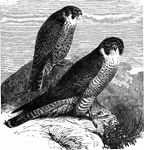
Two Lanner Falcon
"Falco mexicanus. American Lanner Falcon. Prairie Flacon. A medium-sized species, distinguished from…

Peregrine Falcon Small
"Falco peregrinus. Peregrine Falcon. Duck Hawk. Great-footed Hawk. A medium-sized falcon, about as large…